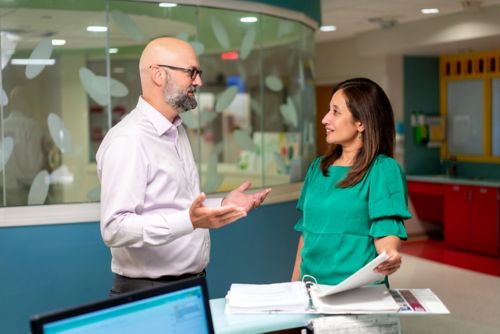St. Jude Family of Websites
Explore our cutting edge research, world-class patient care, career opportunities and more.
St. Jude Children's Research Hospital Home

- Fundraising
St. Jude Family of Websites
Explore our cutting edge research, world-class patient care, career opportunities and more.
St. Jude Children's Research Hospital Home

- Fundraising
Clinical trial disentangles immune issues and boosts anti-cancer effect of bone marrow transplantation

Brandon Triplett, MD, and Swati Naik, MD, St. Jude Department of Bone Marrow Transplantation & Cellular Therapy, presented positive results from a phase II clinical trial aimed to reduce the inherent risks associated with hematopoietic cell transplantation, predominantly graft-versus-host disease.
Patients with leukemia and other hematologic malignancies who don’t respond to chemotherapy often need hematopoietic cell transplantation (also called bone marrow or stem cell transplantation) to treat their cancer. This treatment involves destroying the patient’s bone marrow cells and transplanting new ones from a matched donor.
However, matching patients with a donor, which is done by comparing human leukocyte antigen (HLA) genes, is far more complex than simply matching blood types. “There are hundreds of different variations on each gene, and we try to match at 12 genes, so, the number of combinations of immune type is innumerable,” explains Brandon Triplett, MD, St. Jude Department of Bone Marrow Transplantation & Cellular Therapy, co-corresponding author on recent findings from a phase II clinical trial published in the Journal of Hematology & Oncology. The trial aimed to reduce the inherent risks associated with hematopoietic cell transplantation, predominantly graft-versus-host disease, a by-product of an imperfect donor match.
A perfect match for hematopoietic cell transplantation is very difficult to find. Often, this type of procedure can lead T cells (immune cells produced in bone marrow) to treat their new ‘host’ environment as a foreign pathogen, triggering graft-versus-host disease. “This disease is the opposite of organ transplant rejection,” Triplett explained. “If a kidney is transplanted, the immune system sees that as different and will attack the kidney. With graft-versus-host disease, the new organ is now the immune system. The patient is what is different.”
New transplant strategies allow T cells to know their enemies
Triplett and his collaborators launched the trial (NCT01807611) in 2013 to explore options for patients for whom a perfect bone marrow donor match is unattainable. They hypothesized that by only removing naïve T cells that had not interacted with the protein they were designed to identify, they could leave mature memory T cells in place.
This, they posited, would spare the patient from graft-versus-host disease while also exploiting a strong anti-cancer phenomenon called the graft-versus-leukemia effect, a theory they found to be true. “We showed that you can give large doses of these cells and have a robust and diverse immune system very early after transplant,” Triplett said. “And it was associated with a very low risk of relapse in these patients.”
Considering the dire situation of relapsed or refractory (unresponsive) cases, co-corresponding author Swati Naik, MD, Department of Bone Marrow Transplantation & Cellular Therapy is well aware the impact these results could have on patients. “The patients in remission did extremely well, and the patients who had refractory disease also did well considering that they had no other options, and most transplant centers refrain from taking refractory patients to transplant,” said Naik.
More firepower to combat cancer cells
The clinical trial tested another innovation in bone marrow transplantation by adding natural killer cells to the treatment. These cells further boosted the anti-cancer effects of the transplant. “Natural killer cells are alerted by the absence of molecules that T cells look for,” explained Triplett. “So, the type of cells that are evading T cells are the type of cells targeted by natural killer cells.”
“If you avoid one, you can't avoid the other, so in this study, we're giving a large number of memory T-cells and natural killer cells early after transplant and letting them work together to kill the leukemia and provide extra protection against infections.”
The findings, which both increase the chance of survival and lower the risk of complications, offer hope for patients with the highest-risk disease.
“We're figuring out the right combination of cells that are going to help the patient be successful in that early phase after transplantation and lead to even better long-term outcomes,” Triplett said.






